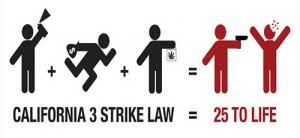
California 3 Strike Law in Ewing v. California
Ewing v. California
Click on the PDF link next to the case title.
The defendant had his third strike when he committed grand theft at a golf course in Los Angeles County. This was not a violent crime but he was subject to the three strikes laws. He appealed this case up to the United States Supreme Court—and lost.
The public has always been worried about violent crime, but just how worried are citizens about nonviolent crime? With mandatory sentencing, society will have many older inmates within the prison system. In the criminal justice community, it is known that inmates “age out of crime.” Can you imagine a 68-year-old man climbing in a window or jumping an 8-foot fence? By keeping these older inmates incarcerated, is this a disservice to society?
State prosecutors have the discretion to lower the charge so that the third offense would not be considered a third strike. For this assignment, you are a policy maker in your state legislature. You are concerned about the heavy tax burden on your constituents. The cost of the actual running of the prison and costs of personnel will rise.
You are also up for re-election, and the feedback that you have received from your constituents has shown that they are dissatisfied with the law that now stands. They are afraid of violent crimes, not just felonies, and are very aware that the last crime committed by the perpetrator does not have to be a violent crime. They are also worried about the use of their tax dollars to incarcerate nonviolent offenders.
Assignment Guidelines
Address the following in 5–7 pages:
Develop a policy regarding the three strikes laws in the State of California. Address the following in your policy:
- What alternatives would be placed in the law to give the state prosecutor more freedom to manipulate the third strike?
- Many prosecutors “load up” charges against defendants to force a plea bargain. What can be done to limit or prevent this practice?
- Will your policy allow multiple counts arising from the same incident to count as multiple strikes? (For instance, a man arrested for aggravated robbery because of the use of a weapon is charged with aggravated robbery and a felony gun possession charge. Should that count as 1 strike or 2?)
- If one of the alternatives was supervised probation, how would you convince the public that it would be more cost-effective for the person to be supervised than incarcerated?
- Show the public where you would be saving money by not incarcerating the perpetrator.
- If brought up in the legislature to be an amendment to the law, could this be grandfathered in to help older inmates?
- Could this have a backlash from the public, or would they approve? How? Why?
Once you are finished with the policy, draft an executive summary of the policy to be used for political decision making.
Use 6–10 scholarly resources to support the provisions of your policy. Dictionaries and encyclopedias are not scholarly sources. Look at federal and state legislation and court cases.
We can write this or a similar paper for you! Simply fill the order form!




